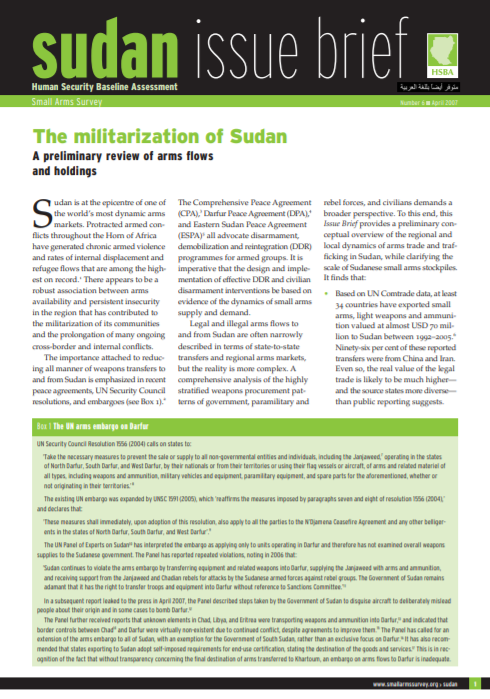
The Militarization of Sudan: a Preliminary Review of Arms Flows and Holdings (HSBA Issue Brief 6)
Sudan is at the epicentre of one of the world’s most dynamic arms markets. Protracted armed conflicts throughout the Horn of Africa have generated chronic armed violence and rates of internal displacement and refugee flows that are among the highest on record. There appears to be a robust association between arms availability and persistent insecurity in the region that has contributed to the militarization of its communities and the prolongation of many ongoing cross-border and internal conflicts. The importance attached to reducing all manner of weapons transfers to and from Sudan is emphasized in recent peace agreements, UN Security Council resolutions, and embargoes (see Box 1).
The Comprehensive Peace Agreement (CPA), Darfur Peace Agreement (DPA), and Eastern Sudan Peace Agreement (ESPA) all advocate disarmament, demobilization and reintegration (DDR) programmes for armed groups. It is imperative that the design and implementation of effective DDR and civilian disarmament interventions be based on evidence of the dynamics of small arms supply and demand.
Legal and illegal arms flows to and from Sudan are often narrowly described in terms of state-to-state transfers and regional arms markets, but the reality is more complex. A comprehensive analysis of the highly stratified weapons procurement patterns of government, paramilitary and rebel forces, and civilians demands a broader perspective. To this end, The Militarization of Sudan: a Preliminary Review of Arms Flows and Holdings provides a preliminary conceptual overview of the regional and local dynamics of arms trade and trafficking in Sudan, while clarifying the scale of Sudanese small arms stockpiles.
Also available in ARABIC.
Have your say about Small Arms Survey publications and products: take 5 minutes to fill out our questionnaire.